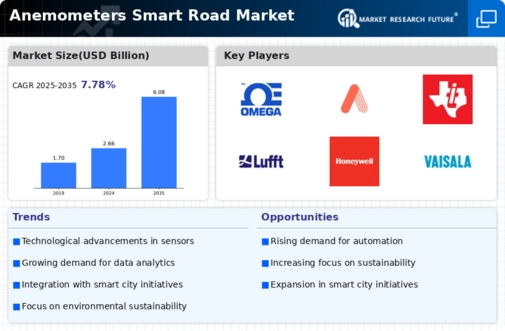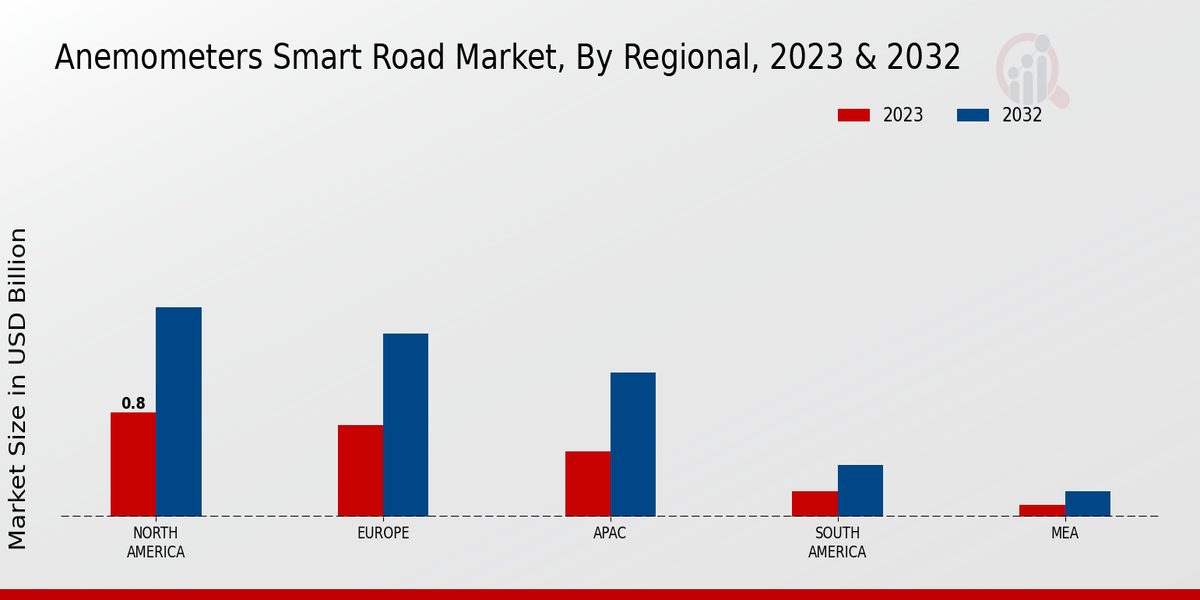Market Growth Projections
The Global Anemometers Smart Road Market Industry is poised for substantial growth, with projections indicating a market size of 2.66 USD Billion in 2024 and an anticipated increase to 6.08 USD Billion by 2035. This growth trajectory reflects a compound annual growth rate (CAGR) of 7.8% from 2025 to 2035. Factors contributing to this expansion include technological advancements, increased government funding, and a growing emphasis on environmental monitoring. As urban areas continue to evolve and prioritize smart infrastructure, the demand for anemometers in road applications is likely to rise, underscoring the market's potential for future development.
Advancements in IoT Technology
The integration of Internet of Things (IoT) technology is transforming the Global Anemometers Smart Road Market Industry. IoT-enabled anemometers provide real-time data on wind speed and direction, facilitating better decision-making for traffic management and infrastructure maintenance. This technological advancement allows for the seamless connectivity of various smart devices, enhancing the overall efficiency of transportation systems. For instance, cities like Los Angeles are deploying IoT solutions to optimize traffic flow based on real-time weather conditions. As the market evolves, the potential for IoT applications in smart roads is expected to drive significant growth, contributing to the projected market size of 6.08 USD Billion by 2035.
Growing Awareness of Road Safety
The increasing awareness of road safety is a significant driver for the Global Anemometers Smart Road Market Industry. With rising traffic accidents attributed to adverse weather conditions, there is a pressing need for accurate weather monitoring systems. Anemometers serve as critical tools in providing real-time data that can inform drivers and traffic management systems about changing wind conditions. Countries like Japan have implemented advanced weather monitoring systems on highways, resulting in improved safety outcomes. This heightened focus on road safety is expected to fuel market growth, as stakeholders recognize the value of integrating anemometers into smart road infrastructure.
Focus on Environmental Monitoring
Environmental concerns are increasingly influencing the Global Anemometers Smart Road Market Industry. Anemometers play a crucial role in monitoring wind patterns, which can impact air quality and pollution levels. As nations strive to meet environmental regulations and sustainability goals, the demand for accurate weather data becomes paramount. For example, the European Union has established stringent air quality standards, prompting cities to adopt smart road technologies that include anemometers. This shift not only aids in compliance but also enhances public health initiatives, thereby driving market growth. The anticipated CAGR of 7.8% from 2025 to 2035 reflects this growing emphasis on environmental monitoring.
Government Initiatives and Funding
Government initiatives and funding are pivotal in shaping the Global Anemometers Smart Road Market Industry. Various countries are allocating substantial budgets to develop smart transportation systems, which include the installation of anemometers for enhanced weather monitoring. For example, the United States Department of Transportation has launched programs aimed at improving road safety through technology. Such initiatives not only provide financial support but also create a conducive environment for innovation in smart road technologies. As these programs gain momentum, they are likely to propel market growth, aligning with the projected CAGR of 7.8% from 2025 to 2035.
Increasing Demand for Smart Infrastructure
The Global Anemometers Smart Road Market Industry is witnessing a surge in demand for smart infrastructure solutions. Governments worldwide are investing heavily in smart city initiatives, which include the integration of advanced technologies such as anemometers to monitor wind conditions on roadways. This trend is driven by the need for improved safety and efficiency in transportation systems. For instance, cities like Amsterdam and Singapore have implemented smart road technologies, enhancing traffic management and reducing accidents. The market is projected to reach 2.66 USD Billion in 2024, indicating a robust growth trajectory as urban areas continue to modernize.













